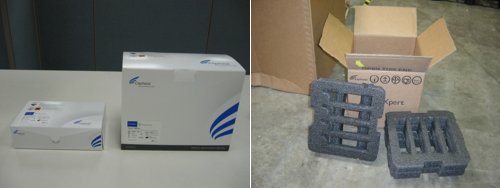Product design for the environment
Cepheid has established formal programs to ensure products and packaging undergo design for environment (DfE) processes to minimize the use of hazardous materials and produce less packaging waste for the consumer. Additionally, Cepheid instrument take-back programs foster product life-cycle stewardship. Sustainable packaging practices have been successfully implemented by several approaches as follows:

Elimination
- Eliminated wood crates by using post-consumer recyclable cardboard for delivery of the GeneXpert-16 System.
- Eliminated the need for cold shipments of product. By shipping at ambient temperatures, cold-packs and Styrofoam are no longer disposed as waste materials.
- Eliminated the need to ship GeneXpert modules for calibration. Modules now undergo remote electronic calibration; thus, totally eliminating the environmental impact of using shipping materials and transportation. For modules previously calibrated in Sunnyvale, we estimate 215 million kg of CO2 no longer generated from module transportation.
Reduction
- Reduced non-recyclable foil packaging >90%.
- Consumable product packaging was reduced 67% by redesigning the container. This significantly reduced packaging materials consumption and transportation weight impact on the environment.
- The Infinity and GeneXpert module transport package weight was redesigned to reduce shipping weight 72% and allow reuse of the container. This reduces packaging materials consumption and transportation weight impact on the environment.
The Cepheid product stewardship program ensures that our product and packaging designs adhere to applicable regional environmental health and safety requirements. Cepheid product literature references these regulations/directives. Specific compliance information is summarized as follows:
- California Prop. 65: (applies to manufactured electrical equipment)
WARNING: Cancer and Reproductive Harm - www.P65Warnings.ca.gov
California Toxics in Packaging Prevention Act: Cepheid uses packaging materials that are compliant with this requirement.
EU Directive on Packaging and Packaging Waste (94/62/EC): Cepheid packaging components are compliant with this directive.
RoHS: Cepheid products are compliant with the RoHS Directive.
REACH (1907/2006/EC): Components in Cepheid’s instrument products may contain substances of very high concern in a concentration greater than 0.1%. Contact Technical Support for more information.
Classification, Labeling, and Packaging of Dangerous Substances (1272/2008): Cepheid has revised product safety data sheets and labels to be compliant with this directive. Safety Data Sheets (SDS)
Waste Electrical and Electronic Equipment (WEEE) (2012/96/EC): Cepheid is exempt from this directive as an in vitro diagnostic medical device supplier where such devices are expected to be infective prior to end of life. However, Cepheid has implemented an electronic take-back program for global returns. Listed below are the regions accepting waste electrical and electronic equipment.
Americas region:
Cepheid Service
632 Caribbean Drive Sunnyvale, CA 94089, USA
Tel: 888-838-3222, Option 2
Fax: +1 408-542-8575
Email: techsupport@cepheid.com
Rest of world:
Cepheid Europe
Vira Solelh 81470 Maurens-Scopont, France
Tel: +33-563-82-53-00
Fax: +33-563-82-53-01
Email: cepheid@cepheideurope.fr
Energy Labeling Directive (2010/30/EU): Cepheid has published energy consumption data in the Operator manuals.
Machinery Directive (2006/42/EC): Cepheid Infinity equipment is compliant with this directive.
Maintain compliance with applicable global regulatory directives
Communicate compliance in product literature
Monitor and comply with new / revised directives that may impact products
Practice continuous improvement by applying design for environment (DfE) in manufacturing and packaging of our products




